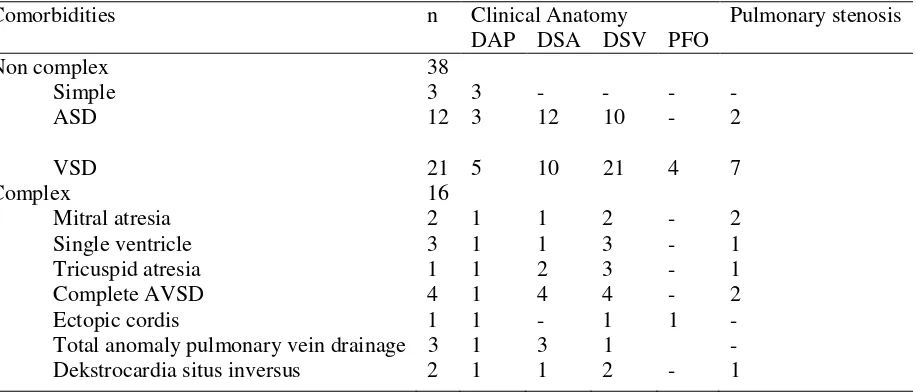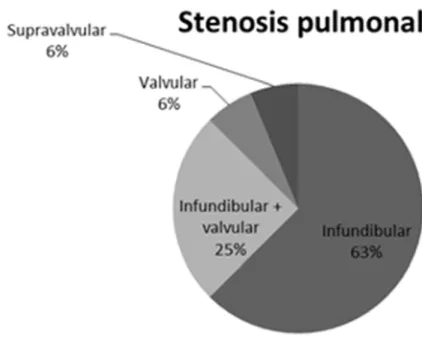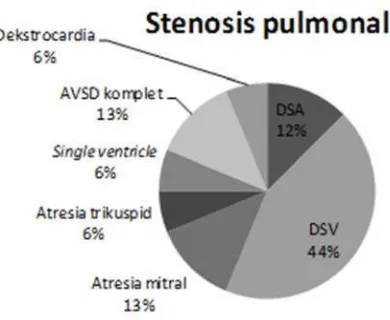TRANSPOSITION OF THE GREAT ARTERIES:
CLINICAL ANATOMI, COMORBIDITIES AND
TYPES OF TRANSPOSISITION
Background.Transposition of the great arteries (TAG) is one of the cyanotic congenital heart disease (CHD) that manifests in the newborn period. Comorbid disorders often found are ventricular septal defect (VSD), atrial septal defect (ASD), patent ductus arteriosus (PDA), and left ventricular outflow tract obstruction.
Purpose.To acknowledge the relationship of the type of transposition with comorbid disorders on the transposition of the great arteries.
The method.This was an analytical descriptive study. The population was all patients who came to the Heart Installation Service Dr. Hasan Sadikin Hospital Bandung to do echocardiography from January 2006 until January 2011. Subjects were all patients who met the inclusion criteria. Diagnosis was confirmed by echocardiography. TAG was divided into 2 groups based on transposition type, the complete transposition and partial transposition. Comorbid disorders in the TAG were divided into two groups, namely the complex and non complex.
Results.During the study, 3910 children were performed echocardiography. There were 54 TAG children who met the inclusion criteria. The youngest age at the time of echocardiography was 4 days, while the oldest was 13 years of age. We found 47 TAG accompanied by DSV, most common type was perimembran, and rarest was doubly commited. We also found 16 children with pulmonary stenosis (mostly infundibular stenosis). Complex comorbid disorders were in the form of TAG with pulmonary stenosis, DSV, found together with other TAG comorbid disorders, namely a complete AVSD, mitral atresia, tricuspid atresia, single ventricle,and dekstrocardia situs inversus. There is a significant relationship with the type of transposition to the comorbid disorders (p = 0.01).
Conclusion.Complete transposition TGA is more often accompanied by complex comorbid disorders.
Key words: transposition of great arteries, complete transposition, partial transposition.
Address of correspondence
DR. dr. Sri Endah Rahayuningsih SpA (K) Department of Pediatrics
Padjadjaran University School of Medicine Dr RS. Hasan Sadikin Bandung
Jl. Pasteur Bandung 38 40 161 Phone / Fax. 022-2034426
Transposition of the great arteries (TAG) is one of the cyanotic congenital heart disease (CHD) that manifests in the newborn period.1,+.2 These abnormalities were found in 5-7% of all congenital heart disease, especially in males.1 , 3The estimated incidence is 1:3.500-5.000 TAG live births. The TAG etiology associated with the disruption of embryology at the time of the formation of arterial trunk. Genetic factors are thought to contribute to the TAG. Without surgical correction, 30% will die during the first week of life and 90% at the age of one year. 5-year survival rate of postsurgical correction is more than 80%.
Comorbid disorders that often found are ventricular septal defect (VSD), atrial septal defect (ASD), patent ductus artiousus (PDA), and left ventricular outflow tract obstruction.3
On TAG there were abnormal arrangement exits of the arteries, the aorta comes out of the right ventricle located anterior to the pulmonary artery, while the pulmonary artery comes out of the left ventricle, situated posterior to the aorta. As a result, aorta receives blood from the vena cava vein, right atrium, right ventricle, and forwarded the blood to the systemic circulation and blood from the pulmonary veins were drained into the left atrium, left ventricle, and forwarded to the pulmonary artery and lungs. Thus, both systemic and pulmonary circulation are separate and life can only take place if there is communication between the two circulation.1.2
Until now there are some varieties of classification of the transposition of the great arteries.4Jaggers et al.5states in complete transposition, the aorta will be out from the right ventricle while the pulmonary artery be out of the left ventricle, as if the aorta and pulmonary artery to move past the ventricular septum. Partial transposition takes place only if one major artery that moves through the septum, whereas the other major arteries remain in place, thus the large artery coming out of the right ventricle (double outlet right ventricle) or from the left ventricle (double outlet left ventricle ).
Complete and partial transpositions are often accompanied by other comorbid disorders that would serve as decision-making about the type of operation to be selected for the correction of TAB.5.6
The purpose of this study is to investigate the characteristics of clinical anatomy, comorbid disorders, the type of transposition, and relationship of the transposition types with comorbid disorders on the TAG.
Method
2011. Subjects were patients who met the TAG inclusion criteria. TAG diagnose was confirmed by echocardiography. Inclusion criteria were patients who have not been performed surgery of TAG, have completed data, and digital files stored on echocardiogram CD at the Heart Installation Service Dr. Hasan Sadikin Hospital Bandung. Complete data included name, gender, birth date, weight, height, date of echocardiography, and interpret results of echocardiography. A complete digital echocardiogram file according to the segmental analysis approaches that include 1) visceral sites, 2) atrioventricular relationship, 3) atrioventricular valve, 4) ventricular morphology, 5) relationship of arterial ventrikulo, 6) the location of large arteries and 7) the infundibulum, and 8) other accompanying disorders.2.7
Echocardiography and Doppler examination performed by a pediatric consultant cardiologist.. Echocardiography performed on children in a state of calm or sleep on the appropriate use of echocardiography Logic General Electric Type 700 and Type General Electric Vivid 3. Examination of two-dimensional, M-mode and M-mode with the Doppler. Echocardiography examination results were stored in the form of digital files on CD.
TAG was divided into 2 groups based on transposition types, complete and partial. Complete transposition, the aorta came out of the right ventricle and the pulmonary artery came out of the left ventricle. Partial transposition was namely only if one major artery that moves through the septum, whereas the other major arteries remain in place, so that the two major arteries coming out of the right ventricle (double outlet right ventricle)or from the left ventricle (double outlet left ventricle).5Comorbid disorders on the TAG divided into two groups, namely the complex comorbid disorders (other than PDA, VSD, ASD, and pulmonary stenosis) and complex (PDA, VSD, ASD, and pulmonary stenosis). Simple TAG was noted only if discovered PDA as a comorbid disorder. Clinical anatomy to see the place of communication between the systemic circulation and pulmonary circulation of theVSD, ASD and PDA.
Result
Table 1. Characteristics of the Data by the Type of Transposition
Characteristics Complete Transposition Partial Transposition Age at diagnose 4 days–72 months 7days–156 months Sex
Boys 11 21
Girls 12 10
The youngest age at the time of echocardiography 4 days, while the oldest 13 years of age.
Table 2. Comorbid disorders on the TAG, clinical anatomy, and pulmonary stenosis
Description:
PDA = duct arteriousus persiten;ASD = atrial septal defect; VSD = ventricular septal defect; persistent foramen ovale PFO =
Most TAG cases accompanied by VSD, some cases were also accompanied by other comorbid disorders, such as PDA, ASD and / or pulmonary stenosis .Only three cases of simple TAG, the TAG was not accompanied by VSD and the ASD only with PDA. We found some rare cases of complex TAG, one case with ectopic cardiac TAG, two cases dekstrocardia situs inversus TAG, and three cases of TAG with total pulmonary vein drainage anomalies.(Table 2)
We found a 13-year-old case with partial transposition, there was a TAG, double outlet right ventricle with pulmonary stenosis and DSV.
Figure 1. DSV type in TAB
Of the 54 cases found 47 cases of TAG accompanied by VSD. Most often type was perimembran, while the rarest was doubly commited type. (Figure 1)
Figure 2. Types of pulmonary stenosis at the TAB
Figure 3. Pulmonary stenosis which is accompanied by other comorbid disorders on the TAB
Pulmonary stenosis most often accompanied the VSD in the case of TAG and can be found together with other TAG comorbid disorders, such as a complete AVSD, mitral atresia, tricuspid atresia, single ventricle,and dekstrocardia situs inversus. (Figure 3)
Table 3. Transposition type relationship with comorbid disorders
Comorbidities Partial Transposition 5 26 31 0,01 Complex Transposition 11 12 23
* Relationship significant if P <0.05
There is a significant association of transposition type with accompanying defects. Complete transpositions are more often accompanied by complex comorbidities, while the partial one is more often accompanied by non complex comorbidities (Table 3).
Discussion
VSD or ASD, there is no mixing of blood between pulmonary and systemic circulation; blood circulation will run parallel which will cause the baby will have severe hypoxia. If we don’t keep the patency of the ductus arteriosus, the baby will die, which is seen in 3 cases simple TAG. In simple TAG, the baby most likely died before being taken to hospital.
Surgery is conducted to correct anatomical abnormalities and there are some types that depend on anatomical abnormalities that accompany TAG. Previous studies suggest that theVSD is a common comorbid disorder found in the TAG, which is at 30% of cases, pulmonary stenosis in 5% of cases, and a combination of VSD and pulmonary stenosis in 10% of cases.8
This is consistent with this study that indicates the type perimembran VSD as common comorbid disorders. Other studies have also shown that of 105 cases performed TAG atrial switch operation (ASO), 67 of whom had perimembran and malalignment with VSD. VSD type role in the postoperative prognosis which perimembran type has a worse prognosis than other types of VSD.9
This study shows 16 (29%) cases of pulmonary stenosis and 7 (12%) cases of pulmonary stenosis cases combined with VSD. (Table 1) Infundibular pulmonary stenosis was the most common type which corresponds to the most common types of obstruction found in previous studies. Other studies have claimed that besides infundibular, can also be found stenosis of thecone-like obstruction,valvular type, pulmonary stenosis due to ventricular septal hypertrophy.10thpulmonary stenosis occurs due to the TAG septum and ventricular wall hypertrophy, fibrous diaphragm, or aneurysm fibrous tissue derived from the membranous septum.2.8
Total anomalous pulmonary venous drainage (TAPVD) is a disorder that causes the pulmonary veins do not empty into the left atrium but empties into a systemic vein or right atrium.3In the present study we found two cases of TAG accompanied with TAPVD. These anatomical abnormalities combination are rare disorders. There were two cases of TAG with infradiafraghm TAPVD type and one case with partial anomalous pulmonary venous drainage of the superior lobe of the lung leading to vertikalis vein, then into the vein inominata, and then to the superior vena cava.11
Bibliography
1. Derrick G, Cullen S. Transposition of the great arteries. Curr Treat Opt Cardiovasc Med. 2000;2:499-506.
2. Salih C, Brizard C, Penny DJ, Anderson RH. Transposition. Dalam: Anderson RH, Baker EJ, Penny D, Redington AN, Rigby ML, Wernovsky G, editor. Paediatric cardiology. Edisi ke-3. Philadelphia: Churchill Livingstone Elsevier; 2010. hlm. 795-817.
3. Park MK. Pediatric cardiology for practitioners. Edisi ke-5. Philadelphia: Mosby Elsevier; 2008. 4. Jacobs JP, Jacobs ML, Mavroudis C, Chai PJ, Tchervenkov CI, Francois G, dkk. Transposition of
the great arteries: lessons learned about patterns of practice and outcomes from, the congenital heart surgery database of the Society of Thoracic Surgeons. World J Pediatr Congenital Heart Surg. 2011;2:19.
5. Jaggers JJ, Cameron DE, Herlong JR, Ungerleider RM. Congential Heart Surgery Nomenclature and Database Project: transposition of the great arteries. Ann Thorac Surg. 2000;69(Suppl 4): S205–35.
6. Hazekamp M, Portela F Bartelings. M. The optimal procedure for the great arteries and left ventricular outflow tract obstruction: an anatomical study. Eur J Cardiothorac Surg. 2007;31:879-87.
7. Anderson RH, Shirali G. Sequential segmental analysis. Ann Pediatr Cardiol. 2009;2:24-35. 8. Anderson RH, Weinberg PM. The clinical anatomy of transposition. Cardiol Young.
2005;15(Suppl 1):76-87.
10. Vázquez-Antona CA, Muñoz-Castellanos L, Kuri-Nivón M, Vargas-Barróna J. Left ventricular outflow tract obstruction in transposition of the great arteries. correlation between anatomic and echocardiographic findings. Rev Esp Cardiol. 2003;56(7):695-702.
11. Lopes LM, Penha Tavares GM, Mailho FL, Cavalcante de Almeida VP, Mangione JA. Echocardiographic diagnosis of transposition of the great arteries associated with anomalous pulmonary venous connection. Arq Bras Cardiol. 2001 Jul;77(1):63-8.


